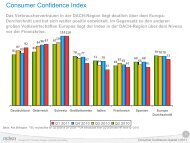You also want an ePaper? Increase the reach of your titles
YUMPU automatically turns print PDFs into web optimized ePapers that Google loves.
Cracking the<br />
C.O.D.E.<br />
A Case Study<br />
Step 1: Consumer profiling<br />
Joe’s Cookies utilized a hybrid of ACNielsen Homescan<br />
Panel data and POS-based profiles to identify its preferred<br />
consumer. Since Joe’s Cookies had low penetration in the<br />
marketplace, the company used panel data to profile the total<br />
category, and then used Spectra Opportunity Finder Solutions<br />
to profile individual SKUs.<br />
The result of this analysis: Joe’s Cookies gained an understanding<br />
of how its brand consumers differed from the overall<br />
cookie category and competitors. The typical Joe’s Cookies<br />
buyer skewed to African-American and Hispanic ethnic makeup,<br />
earned $50,000–$100,000 per year and lived in a household<br />
with children. ■ See chart 1.<br />
Chart 1: Cookie consumer profiles<br />
Joe’s Jane’s<br />
Cookie Cookies Cookies<br />
Category 16 oz. 16 oz.<br />
White Med. High Low High<br />
African Am. Low High Very Low<br />
Hispanic Low High Very Low<br />
< $50K Low Low Low<br />
$50K+ High Very High Medium<br />
$100K+ High Low Very High<br />
No Kids in HH Low Very Low Very High<br />
Kids in HH High Very High Very Low<br />
Source: ACNielsen Homescan & Spectra<br />
Step 2: Opportunity gapping<br />
Joe’s Cookies then ranked retailer stores based on the “fit”<br />
between the store consumer profile and the Joe’s Cookies<br />
consumer profile, quantifying the consumer opportunity gap.<br />
The analysis determined that store opportunity varied greatly<br />
once the consumer was inserted into the equation.<br />
For example, Joe’s Cookies found Store A and Store B identical<br />
in every transactional way. Joe’s Cookies had two facings in<br />
each store, and the store shelf set and total sizes were virtually<br />
identical. However, sales results for Joe’s Cookies were anything<br />
but identical. Store A sold approximately $90 per week of<br />
cookies, while Store B sold closer to $230 per week.<br />
A consumer trade area analysis for each store uncovered very<br />
different shopper bases. Store A was located in an urban setting<br />
with many households without kids in its consumer trade<br />
area. Store B, on the other hand, was in a rural setting with<br />
many households with kids in its consumer trade area. As a<br />
result, Store A was not the underperforming store it initially<br />
appeared to be, but in fact, had captured most, if not all, of its<br />
opportunity. Store B, initially thought to be over-performing in<br />
its trade area, was actually under-performing and should have<br />
sold an incremental $130 more per week. ■ See chart 2.<br />
Instead of allotting resources against a store that appeared to<br />
be an under-performer, Joe’s Cookies targeted the real underperforming<br />
store. Joe’s Cookies followed the C.O.D.E. method<br />
and assessed the different demand drivers and demand<br />
inhibitors affecting the store in order to chart a path for Store B<br />
growth. This exercise was repeated for other chains to diagnose<br />
the amount of unconverted opportunity by account and<br />
develop tactical plan for realizing untapped potential.<br />
Chart 2: Opportunity gapping<br />
Store A: $90 in Sales Store B: $230 in Sales<br />
Consumer Trade Area Consumer Trade Area<br />
Few Kids—Urban<br />
Many Kids—Rural<br />
Consumer Opportunity Gapping<br />
Gap Upside: $8 Gap Upside: +$130!<br />
Source: ACNielsen Homescan & Spectra<br />
48 Fall/Winter 2006











